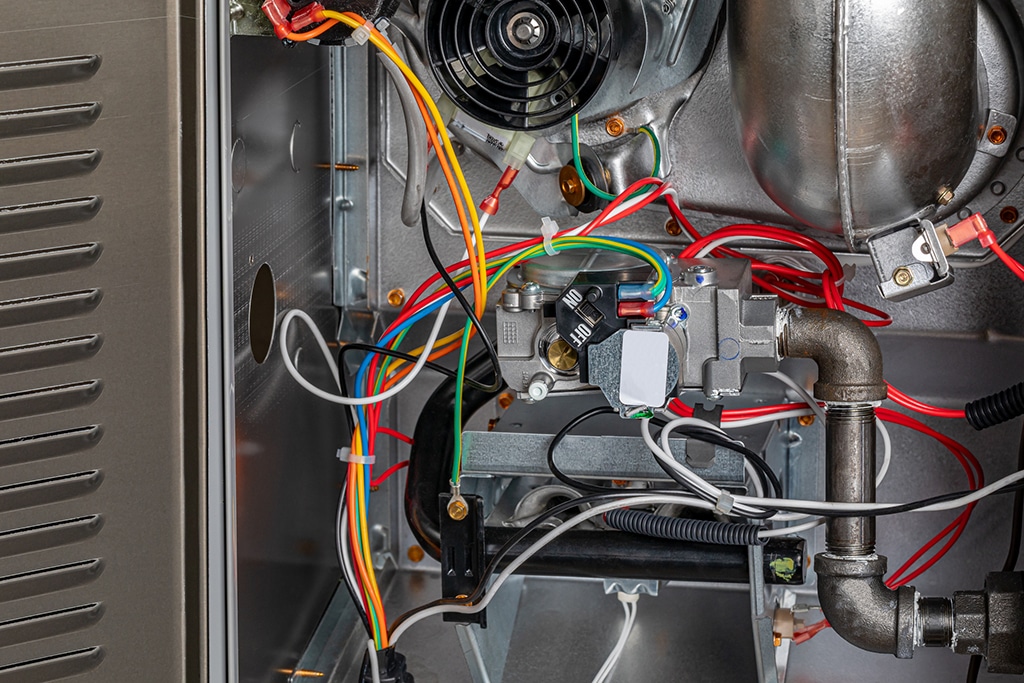
Answering Furnace Blower Motor Questions With Your Experienced Air Conditioning Repair Technician | Frisco, TX
The last thing you need or even want is a heating and air conditioning system that fails when you need it. For this reason, you may have contracted an air conditioning repair technician to inspect your system and service it regularly. However, even when the heating and air conditioning system works as intended, there are likely components that might fail, rendering your furnace inoperable and preventing it from warming your Frisco, TX home when you need it the most. Unfortunately, without the blower motor, the conditioned air cannot be circulated into different parts of your home. But what is a furnace blower motor? Continue reading for answers to this and many other blower motor questions that you could be having.
What’s a Blower Motor in Your Furnace?
A blower motor is a furnace component that pushes or blows the conditioned air via the ductwork into the venting system. This way, the air reaches the different parts of your home. Two types of blower motors are direct and belt drive motors.
Belt Drive Motors
Belt drive motors are connected to the blower fan via a belt. This belt is responsible for transmitting the power to the fan from the motor. Belt drive motors are known for their durability and reliability. This is because they reduce the stress on the motor and prolong its durability. The belt also helps in reducing the noises arising from the blower fan. However, an air conditioning repair technician should check the belt periodically for tension and wear to ensure that the motor operates optimally and lasts longer. You should note that belt drive furnace motors require more maintenance than the direct drive blower motor. However, they are more efficient and powerful when driving large volumes of air. Thus, consider this option if you want your large Frisco, TX home or office cooled or heated.
Direct Drive Blower Motors
Direct drive motors are the other blower motors in an HVAC system or furnace. They are called “direct drives” because they are directly connected to the blower. It means that there is no other form of transmission system or belt. Usually, such motors are more energy efficient than other motors because they eliminate the energy loss that could arise
with the belts and transmission systems. Because they have fewer mechanical or moving parts, these motors are known for their durability and less maintenance. The few moving parts mean a low likelihood of wear and tear. Additionally, direct-drive motors have a quieter operation compared to other motors. Hence, they are popular for use in commercial and residential furnaces. These motors are commonly found in modern HVAC systems. However, they still require routine maintenance by an air conditioning repair technician.
What Are the Main Speeds of Various Furnace Blower Motors?
Residential blower motors feature two popular speed settings; variable speed and single-speed motors.
Variable Speed Blower Motors
These blower motors can operate at different speeds. They have a main advantage in that they are an energy-efficient means of blowing the air. They can keep the internal temperatures of your Frisco, TX home more even. Any slight deviation of temperatures from the desired range will require a slight compensation. If the temperature gap grows too quickly, a variable-speed blower motor will operate at a slightly higher speed to correct the disparity. An experienced air conditioning repair technician should address any issue with your variable-speed motor.
Single Speed Blower Motors
The other motor you can find in your furnace is a single-speed motor. These motors will only blow air at a single high speed until the thermostat set temperatures are reached. The blower motor kicks in whenever the temperatures again deviate too far from the value set on the thermostat. Ensure that your single-speed blower motor is inspected and serviced when the air conditioning repair technician comes for a maintenance visit.
Where Is the Furnace Blower Motor Located?
Most older furnaces featured a squirrel cage blower, which was mounted on the side of the appliance. This type of blower had the motor on the side of the blower. A belt connected the motor spindle to the fan to transmit the spinning motion. The blower, motor, and fan are all distinct components in these older furnaces. Because of this, the air conditioning repair technician can simultaneously conduct repairs or replacements to the motor, the blower, or both of these components.
However, modern furnaces feature a direct-drive design where the blower motor spindle is used for driving the blower wheel. There’s no adjustment belt, and the motor and blower are linked here. The blower fan wheel can be driven by a belt or chain or linked to the gearbox. Further, the motor could be integrated into the blower wheel. It could also be mounted at one end of the component. Regardless, ensure that an air conditioning repair technician handles any issues with the fan or motor.
Modern furnace designs have a blower motor that can be removed or replaced separately. However, certain furnace models have the motors installed as a standalone, single component that can be disconnected, connected, and even reconnected whenever needed. Hence, ensure that you choose a design that suits your needs.
What Does a Furnace Blower Motor Do?
Furnace blower motors are key in determining how quickly your furnace will heat up. If the heating system takes a long to reach your desired temperatures, that will significantly raise the energy utility bills. This arises because your HVAC system runs longer than required, reducing the overall efficiency. Unfortunately, this could result in increased wear and tear on your furnace, necessitating a heating and air conditioning repair. Remember, the blower motor powers the fan that circulates the conditioned air throughout your Frisco, TX home through the vents and air ducts.
How Long Does a Blower Motor Last?
Modern motors are designed to last the same lifespan as the furnace. It means that they will be replaced when replacing the furnace. This could be between 10-20 years, although it heavily depends on the model and make of your furnace. The lifespan of your furnace blower motor also depends on how frequently you have an air conditioning repair technician come over for maintenance.
The more expensive models maintain energy efficiency and performance longer than cheaper ones. However, this isn’t a fast and hard rule. It is pretty critical that you ensure the maintenance requirements are met. Over the lifespan of your furnace, routine maintenance reduces the severity and frequency of air conditioning repairs. Hence, the importance of a blower motor in your furnace cannot be overstated. Any issue with it will affect your entire system.
What Are the Signs the Furnace Blower Motor Has a Problem?
Unfortunately, your furnace blower motor might develop problems even with routine maintenance. You will be prompted to call a heating and air conditioning repair technician whenever this happens. Below are five telltale signs that your blower motor has a problem that needs a replacement or air conditioning repair.
Weak Airflow
Do you notice that the airflow is very weak when you place your hands on the vents? That is a surefire sign that the furnace has a problem. If you put your hand over the vents and notice that the airflow is very feeble, this is an unmistakable sign that there is an issue. Although faulty air ducts could be the root of the problem, in most instances, the blower motor is at the heart of the matter. The component is malfunctioning because your furnace is too old and is past or approaching the end of the rated lifespan.
The same might arise if the heating system is clogged with dust and dirt, restricting its ability to perform properly. If the issue is a faulty capacitor in the furnace blower motor, the part can be fixed to get the furnace back up and operating again. If the issue has been going on for some time, it may be caused by overheating; in this case, a replacement may be required due to accumulated damage. A local heating and air conditioning repair technician in Frisco, TX may examine the state of the furnace blower motor and guide the most effective way to solve the issue.
Increasing Energy Costs
Besides the heat exchanger, no other component of your furnace consumes more energy than the blower motor. This holds even if your furnace runs on a variable-speed motor that is more energy efficient. This energy efficiency may degrade if the furnace blower motor is clogged with debris and dust.
On the other hand, if the blower motor is coming to the end of its rated service life, it may have to work harder to push the treated air via the ducts. Whenever any furnace component works harder, they are prone to stress, wear and tear, and failure. It also means that they might use more energy. Hence, you should have it replaced by a heating and air conditioning repair technician. The other possible reason for the increasing energy costs is leaky air ducts or even an improper furnace installation.
Strange Noises
Strange sounds usually accompany a problem with your furnace blower motor unit or the connected fan. Do you hear clanking, screeching, squealing, or rattling sounds whenever you turn on the furnace or it is running? If you do, you must contact your local heating and air conditioning repair technician for an inspection. The noises in a direct drive furnace blower motor usually indicate motor bearing problems. In older belt drive systems, the noises could mean that the belt is broken or has slipped, much like a car engine with fan belt problems.
Knocking, banging, and rattling sounds could signify that broken parts are loose and moving in your furnace. Unfortunately, the loose parts could cause further damage to any nearby components of the furnace, prompting a need for emergency heating and air conditioning repair. The lubrication within your furnace blower motor should ensure that your unit runs smoothly for many years. However, if you hear a grinding or screeching noise, that could mean that the blower motor bearings are grinding against each other.
Strange Odors
When your furnace is operating, if you notice a burning smell coming from the vents, the blower motor may cause the issue. If the motor tends to overheat, you might find that it pauses while the heat is on, or the system might completely shut down. The HVAC system contains built-in safety features to guard your home and appliance against electrical damages, and they will remain in place until an air conditioning repair technician in Frisco, TX resolves the root problem.
No Airflow
Have you noticed that the furnace isn’t blowing warm air into your home? Is there no air flowing from the vents even when the furnace is running? That could be a sign of a serious underlying problem. If the problem is with the blower motor, there is no point in running your system as the conditioned air cannot be pushed to other sections of your home. Since this issue can also be caused by a faulty thermostat or even a fan control problem, you should have your furnace inspected and fixed by a reliable heating and air conditioning repair technician.
Should You Replace the Furnace Blower Motor?
Whenever a blower motor fails, and your furnace is too old, you might have to choose between having an air conditioning repair technician in Frisco, TX install a new one or replace the entire furnace. Making the judgment between repair or replacement could prove a hard option. However, if your furnace is closer to 20 years, replacing it altogether could be the most economically sound option. This is because the frequent repairs could be money-draining.
We Can Help with Your Furnace Blower Motor Problems
Are you experiencing furnace blower motor issues? Contact us at One Hour Air Conditioning & Heating of Dallas. Our experienced professionals will reliably fix it to ensure that your home is properly heated.







